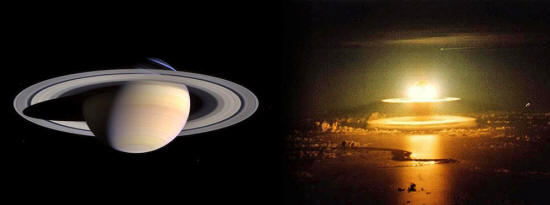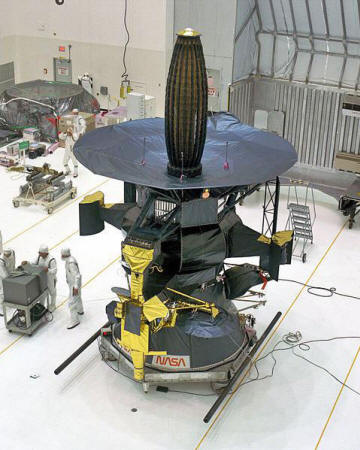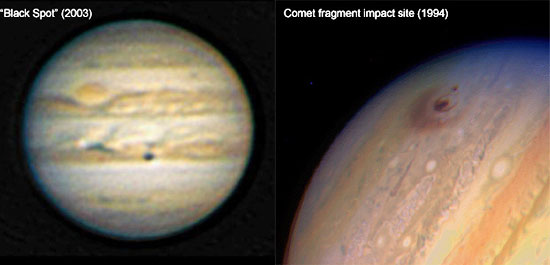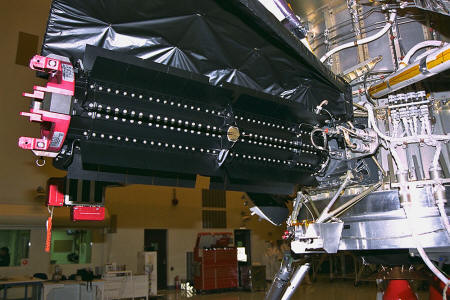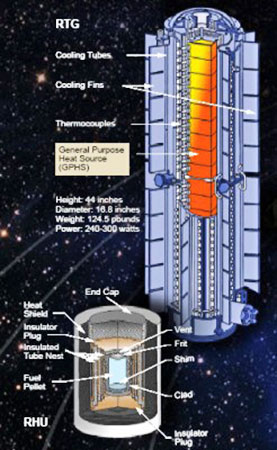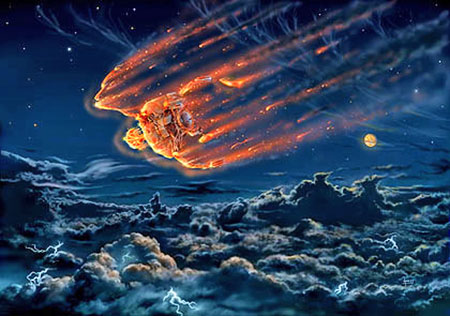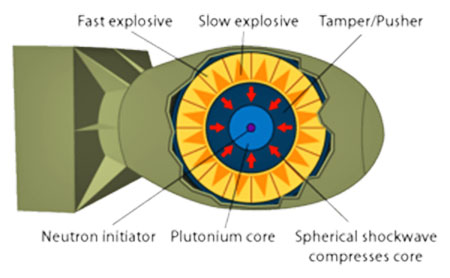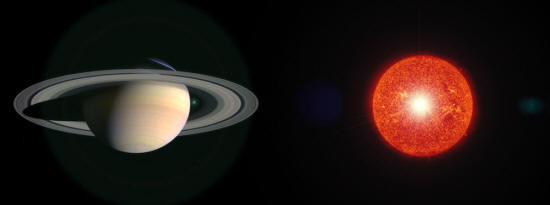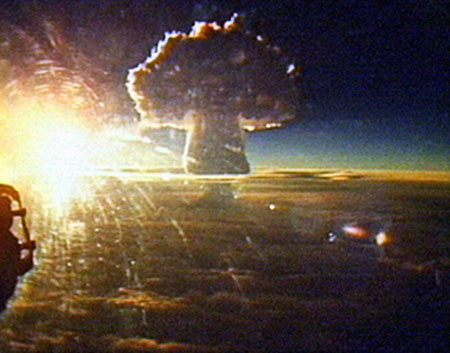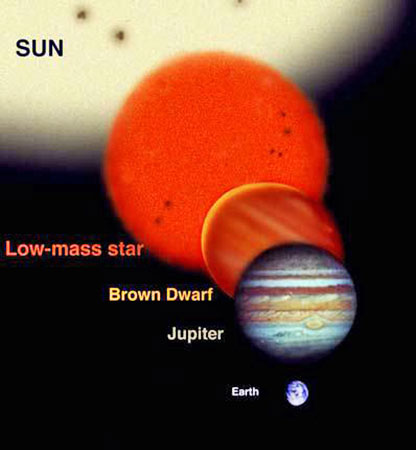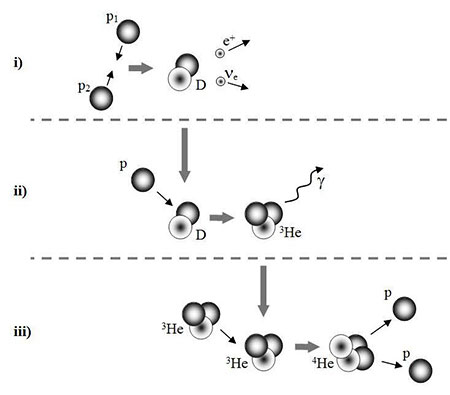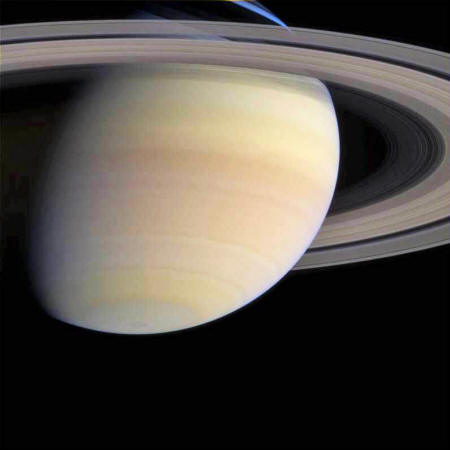|
July 24, 2008
Project Lucifer. Could the plutonium fuel onboard the Cassini mission cause a nuclear chain reaction on Saturn? Credit: NASA/US Department of Defense
So what happened when Galileo dropped into Jupiter?
Galileo undergoing preparations before launch in 1989. Credit: NASA
Well… nothing really.
In 2003, NASA took the prudent decision to terminate the hugely successful Galileo mission by using its last drops of propellant to push it at high speed into the gas giant.
By doing so, this ensured the probe would burn up during re-entry, dispersing and burning any contaminants (such as terrestrial bacteria and the radioactive plutonium-238 fuel on board).
The primary concern about letting Galileo sit in a graveyard orbit was that if mission control lost contact (very likely as the radiation belts surrounding Jupiter were degrading the probe's ageing electronics), there may have been the possibility that Galileo would crash into one of the Jovian moons, contaminating them and killing any possible extra-terrestrial microbial life.
This was a serious concern, especially in the case of Europa which could be a prime location for life to thrive below its ice-encrusted surface.
Now this is where the intrigue begins.
Long before Galileo plummeted into Jupiter's atmosphere, conspiracy theorists cited that NASA wanted to create an explosion within the body of the gas giant, thus igniting a chain reaction, creating a second sun (Jupiter is often called a ‘failed star', although it has always been way too small to support nuclear reactions in its core).
This was proven wrong on many counts, but there were three main reasons why this could not happen:
Five years after the Galileo impact, Jupiter still looks to be in fine health (and it certainly isn't close to being a star).
Although history has already proven you can't create a star from a gas giant using a space probe (i.e. Jupiter + Probe ≠ Star), conspiracy theorists think that NASA's evil plan failed and there is some evidence that something did happen after Galileo got swallowed by Jupiter (and that NASA is pinning their hopes on the Cassini/Saturn combo).
Cue the Big Black Spot
The mystery black spot in 2003 (by Eric Ng) compared with one of the Shoemaker-Levy 9 fragments impact sites in 1994 (NASA)
Backing up the conspiracy theorists' claims that there was an explosion inside the Jovian atmosphere after Galileo hit was the discovery of a dark blob near the equator of Jupiter a month after the event.
This was widely reported across the web, but only a couple of observations were made before it disappeared. Some explanations pointed out that the blob could have been a short-lived dynamic atmospheric feature or it was a shadow from one of the Jovian moons.
After this initial excitement, nothing else surfaced about the phenomenon.
However, some were keen to point out that the dark patch on Jupiter's surface may have been a manifestation of a nuclear detonation from Galileo deep within the planet which, after a month, eventually floated to the surface. Comparisons had even made with the 1994 features generated by the impact of the pieces of Comet Shoemaker-Levy 9 (pictured above).
What ever the cause of this dark feature, it didn't come from Galileo as a nuclear detonation simply was not possible.
What's more, a nuclear detonation from the Cassini mission when it enters Saturn's atmosphere in 2010 is also impossible, and here's why…
The Radioisotope Thermoelectric Generators (RTGs)
The Cassini RTG, one of three on board. Credit: NASA
RTGs are a tried and tested technology in use since the 1960's.
Various RTG designs have been used on a huge number of missions including,
...and, most recently, New Horizons.
RTGs are a very dependable source of power for space missions where solar panels have not been an option. For Cassini, if solar panels were used, they would need to have a huge area to collect the meager sunlight at 10 AU, thus impractical to launch and operate.
The three RTGs on board Cassini are fuelled by small pellets of plutonium-238 (238Pu) encased separately in shock-proof containers known as general purpose heat source modules. There are 18 modules in each RTG. Through the use of thermocouples, the steady heat generated by the radioactive decay of the plutonium isotope is converted into electricity to supply Cassini.
It is worth noting at this point that 238Pu is not weapon grade (i.e. it is very difficult to generate nuclear fission, 239Pu is more suited for this purpose).
There are also dozens of Radioisotope Heater Units (RHUs) on board Cassini that provide a steady heat to critical subsystems, which contain single pellets of Pu-238.
Again, these units are separated and shielded, each weighing 40 grams.
For more details on this, check out the NASA Factsheet: Spacecraft Power for Cassini.
Inside an RHU and RTG (Roland Piquepaille)
Shielding is critical for each plutonium pellet, primarily to prevent radioactive contamination during launch of space missions.
Should there be an incident during launch, space agencies such as NASA must assure the containment of the radioactive material. Therefore all RTGs and RHUs are completely safe regardless of the stresses they are put under.
So, like Galileo, Cassini will hit Saturn's atmosphere at a high velocity (Galileo hit the Jovian atmosphere at a speed of 50 km/s) and disintegrate very quickly before burning to a cinder.
The point I want to highlight here is that Cassini will break apart like any fast-moving object during re-entry.
Still, conspiracy theorists are quick to point out that Cassini is carrying a huge amount of plutonium, totaling 32.8 kg (even though it is not the weapon-grade 239Pu and all the bits of 238Pu are tiny pellets, encased in damage-proof containers, being scattered through Saturn's atmosphere).
But ignoring all the logical arguments against, it will still generate a nuclear explosion, right?
Alas, no.
So how does a nuclear bomb work anyway?
Artist impression of Galileo burning up when falling into the Jovian atmosphere. Credit: David A Hardy
So there's Cassini, plummeting through Saturn's atmosphere in two years time.
As it gets deeper, bits fall off and burnt by the friction caused by re-entry. When I say fall off, I mean they are no longer attached. For a nuclear detonation to occur we need a solid mass of weapon grade plutonium.
By solid mass, I mean we need a minimum amount of the stuff for nuclear fission to occur (a.k.a. "critical mass"). The critical mass of 238Pu is approximately 10 kg (US DoE publication), so Cassini has enough 238Pu for three crude nuclear bombs (ignoring the fact that it is very difficult to build a 238Pu weapon in the first place).
But how could all those tiny pellets of 238Pu be pulled together, in free-fall, casings removed, letting the pressure of Saturn's atmosphere force it all together tipping it toward critical mass?
Is that really possible? No.
An imploding nuclear weapon (answers.com)
Even if by some chance all the 238Pu in one RTG melded together, how would it detonate?
For detonation of an implosion-triggered fission bomb to occur, sub-critical masses need to be forced together at the same instant. The only way this is possible is to surround the sub-critical masses with high-explosives so a shock wave rapidly collapses the sub-critical masses together.
Only then may a chain reaction be sustained. Unless NASA has been really sneaky and hidden some explosives inside their RTGs, detonation is not possible. Using atmospheric pressure alone is not a viable explanation.
Now we can see that it is pretty much impossible for the plutonium on board Cassini to create a nuclear explosion. But if there was a nuclear detonation, could a chain reaction occur?
Could Saturn become a star?
July 31, 2008
Project Lucifer. Could the plutonium fuel onboard the Cassini mission cause a nuclear chain reaction on Saturn? Credit: NASA
Thermonuclear bombs
The Soviet 50-megaton Tsar Bomba, the largest weapon ever detonated (1961)
Unless nuclear fusion can be maintained within a stellar body, the reaction will very quickly fizz out.
So the Lucifer Project proposes Cassini will plunge many hundreds of miles into the atmosphere of Saturn and explode as a crude plutonium-fuelled fission explosion. This explosion will cause a chain reaction, creating enough energy to trigger nuclear fusion inside the gas giant.
I can see where this idea has come from, even though it is inaccurate. The fusion bomb (or "thermonuclear weapon") uses a fission trigger to kick-start an uncontrolled fusion reaction. The fission trigger is constructed to explode like a normal fission bomb much like the implosion device described in Part 1 above.
When detonated, huge quantities of energetic X-rays are produced, heating the material surrounding the fusion fuel (such as lithium deuteride), causing the phase transition to a plasma. As very hot plasma is surrounding the lithium deuteride (in a very confined and pressured environment) the fuel will produce tritium, a heavy hydrogen isotope.
Tritium then undergoes nuclear fusion, liberating huge quantities of energy as the tritium nuclei are forced together, overcoming the electrostatic forces between nuclei and fusing.
Fusion releases large quantities of binding energy, more-so than fission.
How does a star work?
A comparison of the size of Jupiter, a brown dwarf, a small star and the Sun (Gemini Observatory/Artwork by Jon Lomberg)
The point that needs to be emphasized here is that in a thermonuclear device, fusion can only be attained when immense temperatures are reached within a very confined and pressurized environment. What's more, in the case of a fusion bomb, this reaction is uncontrolled.
So, how are nuclear fusion reactions sustained in a star (like our Sun)?
In the thermonuclear bomb example above, tritium fusion is achieved through inertial confinement (i.e. rapid, hot and energetic pressure on the fuel to cause fusion), but in the case of a star, a sustained mode of confinement is required. Gravitational confinement is needed for nuclear fusion reactions to occur in the core.
For significant gravitational confinement, the star requires a minimum mass.
In the core of our Sun (and most other stars smaller than our Sun), nuclear fusion is achieved through the proton-proton chain (pictured below).
This is a hydrogen burning mechanism where helium is generated. Two protons (hydrogen nuclei) combine after overcoming the highly repulsive electrostatic force. This can only be achieved if the stellar body has a large enough mass, increasing gravitational containment in the core.
Once the protons combine, they form deuterium (2D), producing a positron (quickly annihilating with an electron) and a neutrino. The deuterium nucleus can then combine with another proton, thus creating a light helium isotope (3He).
The outcome of this reaction generates gamma-rays that maintain the stability and high temperature of the star's core (in the case of the Sun, the core reaches a temperature of 15 million Kelvin).
The proton-proton chain that fuels nuclear fusion inside the core of our Sun. Credit: Ian O'Neill
As discussed in a previous Universe Today article, there are a range of planetary bodies below the threshold of becoming a "star" (and not able to sustain proton-proton fusion).
The bridge between the largest planets (i.e. gas giants, like Jupiter and Saturn) and the smallest stars are known as brown dwarfs. Brown dwarfs are less than 0.08 solar masses and nuclear fusion reactions have never taken hold (although larger brown dwarfs may have had a short period of hydrogen fusion in their cores).
Their cores have a pressure of 105 million atmospheres with temperatures below 3 million Kelvin.
Keep in mind, even the smallest brown dwarfs are approximately 10 times more massive than Jupiter (the largest brown dwarfs are around 80 times the mass of Jupiter).
So, for even a small chance of the proton-proton chain occurring, we'd need a large brown dwarf, at least 80 times bigger than Jupiter (over 240 Saturn masses) to even stand the hope of sustaining gravitational confinement.
There's no chance Saturn could sustain nuclear fusion?
Saturn, seen by Cassini. Image credit: NASA/JPL/SSI
Sorry, no. Saturn is simply too small.
Implying that a nuclear (fission) bomb detonating inside Saturn could create the conditions for a nuclear fusion chain reaction (like the proton-proton chain) is, again, in the realms of science fiction. Even the larger gas giant Jupiter is far too puny to sustain fusion.
I have also seen arguments claiming that Saturn consists of the same gases as our Sun (i.e. hydrogen and helium), so a runaway chain reaction is possible, all that is needed is a rapid injection of energy.
However, the hydrogen that can be found in Saturn's atmosphere is diatomic molecular hydrogen (H2), not the free hydrogen nuclei (high energy protons) as found in the Sun's core.
And yes, H2 is highly flammable (after all it was responsible for the infamous Hindenburg airship disaster in 1937), but only when mixed with a large quantity of oxygen, chlorine or fluorine.
Alas Saturn does not contain significant quantities of any of those gases.
Conclusion
Part 1 above, introduced the conspiracy and focused on some of the general aspects why the Galileo probe in 2003 simply burned up in Jupiter's atmosphere, scattering the small pellets of plutonium-238 as it did so. The "black spot" as discovered the next month was simply one of the many dynamic and short-lived storms often seen to develop on the planet.
This article has gone one step further and ignored the fact that it was impossible for Cassini to become an interplanetary atomic weapon.
What if there was a nuclear explosion inside Saturn's atmosphere? Well, it looks like it would be a pretty boring affair. I dare say a few lively electrical storms might be generated, but we wouldn't see much from Earth.
As for anything more sinister happening, it is highly unlikely there would be any lasting damage to the planet. There would certainly be no fusion reaction as Saturn is too small and it contains all the wrong gases.
Oh well, Saturn will just have to stay the way it is, rings and all.
When Cassini completes its mission in two years time, we can look forward to the science we will accumulate from such an incredible and historic endeavor rather than fearing the impossible…
|


